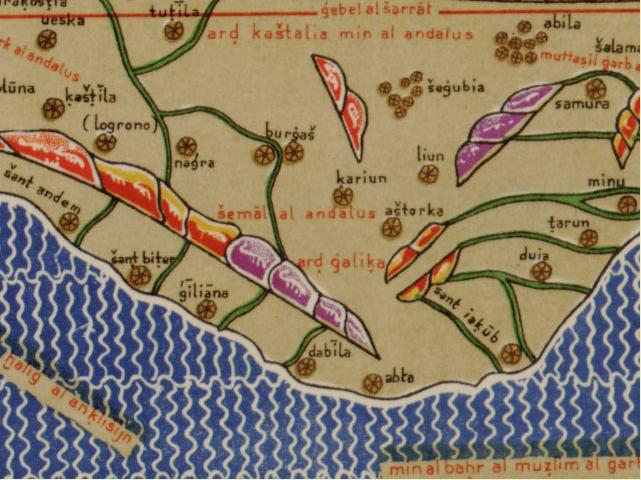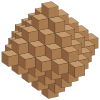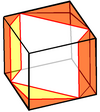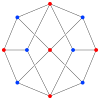User:WordSeventeen/Notes
Appearance
Notations
[edit]
Copiale Cipher; scaled page 16/17 2011 Source Kevin Knight, [1] Author 18th century
maps
[edit]
Detalle do noroeste da peninsula ibérica na Tábula Rogeriana de Al Idrisi, na transcripción latina de Konrad Miller de 1928. Pódese obter un mapa de detalle da Tábula Rogeriana na seguinte dirección á web da Libraría do Congreso dos EEUU.
dyk ~ coding from David Eppstein
[edit]- ... that James Colliander, Gigliola Staffilani, and Terence Tao are part of a collaborative group of mathematicians called the I-team? (15.01)
- ... that mathematician Linda Preiss Rothschild settled for graduate study at MIT after Princeton rejected her for being female? (15.01)
- ... that Ioana Dumitriu began taking graduate mathematics courses as a college freshman, and became the first female Putnam Fellow the following year? (15.01)
- ... that Fermat's only complete proof shows there is no integer right triangle with square area, pair of integer right triangles sharing two sides, or square gap between three equally spaced squares? (15.01)

- ... that Northwest Coast artist Jim Hart is a hereditary chief of the Haida Nation? (14.08)
- ... that 19th-century French geometer Olry Terquem, writing as "Tsarphati", was an outspoken advocate of the Reform movement in Judaism? (14.07)
- ... that mathematician and author C. Stanley Ogilvy was an avid sailor who frequently competed in the Star World Championships? (14.07)
- ... that book embeddings of graphs have been used to model fault-tolerant computer systems, the phases of traffic lights, and pseudoknots in RNA molecules? (14.06)


- ... that the subjects of Marjorie Senechal's books include quasicrystals, Albania, and silk? (13.07)
- ... that according to the Gilbert–Shannon–Reeds model of probability distribution, a deck of playing cards should be riffled seven times in order to thoroughly randomize it? (13.07)

- ... that mathematician Andrew Gleason liked to say that proofs "really aren't there to convince you that something is true—they're there to show you why it is true"? (13.04)
- ... that Latvian-American mathematician Lipman Bers was also a human rights activist and a founder of the Committee on Human Rights of the National Academy of Sciences? (13.04)
- ... that circular layouts, in which the nodes of a graph are drawn on a circle, have been used to visualize the cyclic parts of metabolic networks? (13.03)
- ... that William Allen Whitworth was the first mathematician to publish Bertrand's ballot theorem, one of many misnamed mathematical theorems? (13.03)
- ... that because of the possibility of dead heats, the number of possible outcomes of a horse race is not a factorial, but an ordered Bell number? (13.03)
- ... that in the square of a graph, all vertices with a distance of no more than two in the original graph are adjacent? (13.03)
- ... that Karl Beth is considered one of the founding fathers of the psychology of religion? (12.10)
- ... that William W. Cooper, a pioneer of management science, dropped out of high school and worked as a professional boxer before becoming an academic? (12.10)
- ... that Andrew Vázsonyi became past president of The Institute of Management Sciences without ever having been its president? (12.10)

- ... that a tomahawk may be used to split an angle into three equal parts, despite the impossibility of doing so with compass and straightedge? (12.09)
- ... that John Hilliard's Cause of Death (1974) suggested four different interpretations of one photographic negative? (12.09)

- ... that Nicolas de Bruijn was inspired to prove De Bruijn's theorem on packing bricks into boxes by his seven-year-old son's inability to pack some bricks into a box without wasted space? (12.09)
- ... that the shape that encloses two given volumes and has the minimum possible surface area is the double bubble commonly formed by soap bubbles? (12.07)

- ... that Albert Brahms kept the first known records of the tide levels on the North Sea coast of Germany? (12.05)
- ... that artist Tina Mion, of Winslow, Arizona, grew up visiting the museums of her birthplace, Washington, D.C., whose National Portrait Gallery now holds two of her works in its permanent collection? (12.05)
- ... that the number of ways to place n diagonally symmetric rooks on an n × n chessboard in such a way that no two rooks attack each other is a telephone number? (12.04)
- ... that swarms of Japanese soldier crabs of the species Mictyris guinotae, named after French biologist Danièle Guinot, can be used in place of the billiard balls in billiard-ball computers? (12.04)
- ... that the Latvian mathematician Emanuels Grīnbergs lost his job and his doctoral degree for serving in the German Army during World War II, but then regained both by writing a new thesis? (12.04)
- ... that the Healdsburg Memorial Bridge in Healdsburg, California, was the first steel bridge across the Russian River? (12.01)

- ... that Hendy Woods State Park, an old-growth coast redwood forest in the Anderson Valley of northern California, is scheduled to be closed in 2012 because of state budget cuts? (12.01)


- ... that despite leaving school at age 14, Thomas Kirkman became one of 19th-century England's leading mathematicians and helped found combinatorial design theory? (11.10)
- ... that the Sint Servaasbrug in Maastricht has been called the oldest bridge in the Netherlands, and was built in the 13th century to replace a Roman bridge that gave its name to the city? (11.10)
- ... that Michel Demazure, a mathematician from the pseudonymous Nicolas Bourbaki group, led two French science museums, the Palais de la Découverte and the Cité des Sciences et de l'Industrie? (11.08)
- ... that the De Bruijn–Erdős theorem may be used to extend the four-color theorem from finite planar graphs to planar graphs with infinitely many vertices? (11.07)
- ... that the Theil–Sen estimator can accurately fit a line to a set of sample points even when up to 29% of the points have been arbitrarily corrupted? (11.07)
- ... that the Malfatti circles, three tangent circles inside a triangle, are named after Malfatti because of an incorrect conjecture he made, and were studied earlier by Ajima and di Cecco? (11.06)
- ... that the widest path problem forms the algorithmic basis of the Schulze method used by Wikimedia to decide the winners of multiway elections? (11.05)

- ... that John R. Isbell was the primary contributor to the mathematical theory of uniform spaces? (11.04)
- ... that Edgar Gilbert investigated the mathematics of shuffling playing cards? (11.03)
- ... that, in the Rule 90 cellular automaton, any finite pattern eventually fills the whole array of cells with copies of itself? (11.02)
- ... that The Princeton Companion to Mathematics is the 2011 winner of the Mathematical Association of America's Euler Book Prize? (11.02)
- ... that block cellular automata, invented by Norman Margolus, can be used to simulate lattice gases, sand piles, and billiard-ball computers? (11.02)

- ... that Andreu Mas-Colell, currently the Minister of Economy and Knowledge of Catalonia, Spain, has studied general equilibrium theory by using differential topology? (11.01)
- ... that Graciela Chichilnisky, who proposed the Kyoto Protocol's market for carbon credit trading, obtained her PhDs in mathematics and economics without ever having been an undergraduate? (11.01)
- ... that Starr's corollary to the Shapley–Folkman lemma was proved by an undergraduate student of Kenneth Arrow? (10.10)
- ... that Paul Erdős challenged Jon Folkman to solve mathematical problems immediately after Folkman's surgery for brain cancer? (10.10)
- ... that every round-robin tournament either has a set of players who win all games against players outside the set, or its graph of wins and losses is pancyclic, having directed cycles of all lengths? (10.09)

- ... that Coretta Scott King called African-American civil rights activist Randolph Blackwell an "unsung giant" of nonviolent social change? (10.08)

- ... that Konocti Harbor, a now-closed resort and music venue in Lake County, California, was originally founded in 1959 as low-cost vacation housing for members of a plumbers union? (10.08)
- ... that Mendocino, California, artist Bill Zacha learned to paint left-handed after injuring his right hand in a fall? (10.06)
- ... that Canadian astrophysicist Victoria Kaspi was one of the first to observe the cosmic recycling of pulsars? (10.02)

- ... that the clique problem of programming a computer to find complete subgraphs in an undirected graph was first studied as a way to find groups of people who all know each other in social networks? (09.12)
- ... that psychiatrist Marie Nyswander, who developed the methadone treatment for heroin addicts, was herself addicted to cigarettes? (09.12)
- ... that Matthew T. Dickerson is a computational geometer, scholar of J. R. R. Tolkien and the Inklings, novelist, blues musician, fly fisherman, maple sugar farmer, and beekeeper? (09.11)


- ... that a casket discovered by Anant Sadashiv Altekar near Vaishali, on display at the Patna Museum, is said to contain the remains of the Buddha? (09.09)
- ... that Martin Demaine founded the first one-man art glass studio in Canada and home-schooled his son Erik to become MIT's youngest ever professor despite not having a college degree himself? (09.09)

Frederick W. Panhorst Bridge - ... that the Life without Death cellular automaton, a mathematical model of pattern formation, is a variant of Conway's Game of Life in which cells, once brought to life, never die? (09.06)
- ... that Donald G. Fink, later to become a prominent electrical engineer, was selected as the best orator in his county at a high school competition? (09.06)

- ... that the first textbook in Hungarian, an encyclopedia by János Apáczai Csere, was written and published in The Netherlands? (09.03)


- ... that no matter how biased a coin one uses, flipping a coin to determine whether each edge is present or absent in a countably infinite graph will always produce the same graph, the Rado graph? (09.03)
- ... that Victor Vacquier escaped Russia by sleigh across the frozen Gulf of Finland and went on to pioneer the use of submarine detectors for investigating plate tectonics? (09.02)
- ... that there are 115,200 solutions to the ménage problem of permuting six couples at a twelve-person table so that men and women alternate and are seated away from their partners? (09.01)

- ...that Dutch topologist Johannes De Groot is the academic grandfather, great-grandfather, and great-great-grandfather of his namesake via four different paths of academic supervision? (08.04)
- ...that Carl Størmer, "the acknowledged authority" on aurorae and the motion of charged particles in the magnetosphere, began his academic career inventing formulae for π? (08.03)
- ...that Scripps marine chemist Edward D. Goldberg suggested using mussels to measure the amount of pollution in the oceans? (08.03)
- ...that television pioneer Thomas T. Goldsmith, Jr. became the inventor of the video game when he took out a video game patent in 1948? (08.03)
- ...that in Floyd's algorithm for cycle detection, the tortoise and hare move at very different speeds, but always finish at the same spot? (07.10)
- ...that in graph theory, a pseudoforest can contain trees and pseudotrees, but cannot contain any butterflies, diamonds, handcuffs, or bicycles? (07.10)

- ...that the six permutations of the vector (1,2,3) form a hexagon in 3d space, the 24 permutations of (1,2,3,4) form a truncated octahedron in four dimensions, and both are examples of permutohedra? (07.08)

- ...that the Rule 184 cellular automaton can simultaneously model the behavior of cars moving in traffic, the accumulation of particles on a surface, and particle-antiparticle annihilation reactions? (07.05)

- ...that a cyclic cellular automaton (pictured) is a system of simple mathematical rules that can generate complex patterns mixing random chaos, blocks of color, and spirals? (07.04)
- ...that a nonconvex polygon with three convex vertices is called a pseudotriangle? (07.04)

























